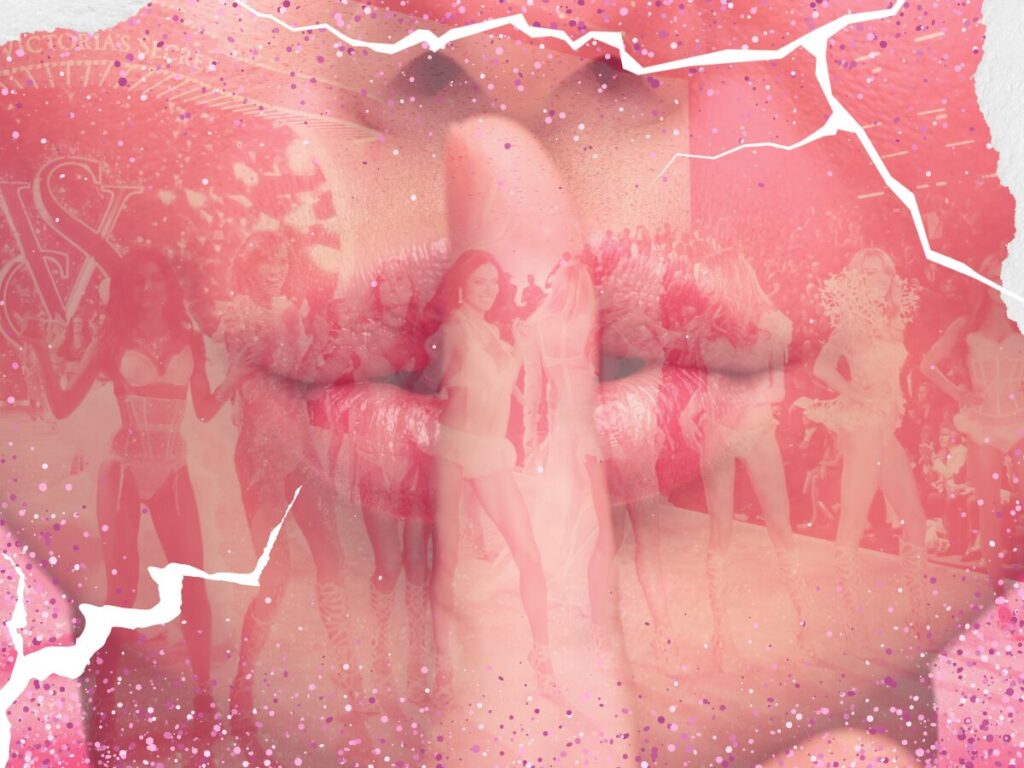In the noughties and the early 2010s, Victoria’s Secret was a disturbing, neon-pink monolith that stood for…something. It wasn’t relatability for sure, or girl power, it was kind of an untouchable ‘we’re better than you’ vibe that permeated from the heavy vanilla-scented fog that billowed from its blindingly glittery high-street shops. I, for one, have always approached a VS Pink store with the trepidation of a sleeping bear, knowing I’m one size 2 thong away from a complete mental breakdown. Which is why, in 2019, when the beast was defanged, I was the first to revel in its downfall.
So, imagine my shock when Victoria’s Secret announced that after a 5-year hiatus, their infamous Victoria’s Secret Fashion Show was not only back, but this time “all about women”. So it’s time to don your bucket hats, rewatch friends and squeeze yourself into a pair of low-waisted jeans, because the 90s are back, and this time it’s somehow worse.
Lingerie for women (for men)
Victoria’s Secret was established in 1977 by American businessman Roy Raymond, because he couldn’t find anywhere to buy his wife some sexy lingerie. He described how he could only find terry cloth robes and dowdy nylon nightgowns and how he felt like an “unwanted intruder” in lingerie stores for women. Named after the 19th Century British Queen Victoria, the name was supposed to hint at something sexy beneath the stiff upper lip of Victorian society. The store gained vast popularity because finally there was a safe space for men in the high street! The stores spread like a sexy pink plague across the world and the store’s popularity reached an all-time high in 1995, when they decided to do a fashion show.
I could be your angle or your devil 😈
The first Victoria’s Secret Fashion Show (VSFS) hit America in 1995, it was a far cry from what they became. With models wearing tiny cardigans over their very demure and mindful lingerie ensembles. Over the next 24 years, the VSFS became a cultural phenomenon starring very thin, beautiful models wearing enormous feathered angel wings. These ‘Victoria’s Secret Angels’ were fabulous and completely untouchable. Generally white, blonde and no bigger than a size 6, all sung onto the catwalk by horrendously famous singers like Taylor Swift, Harry Styles or Fall Out Boy. As the 2020’s approached, a move towards body diversity meant that the fashion shows were starting to gain criticism for their lack of body positivity.
An angel who flew too close to the sun
Hours before their 2018 show, Victoria’s Secret’s Chief Marketing Officer dropped a bomb which essentially killed the brand. Speaking to Vogue he said “Shouldn’t you have transsexuals in the show? No. No, I don’t think we should. Well, why not? Because the show is a fantasy. It’s a 42-minute entertainment special. That’s what it is.” Not only was he panned for the use of an outdated transphobic slur, his comments showed everything people knew to be true: Victoria’s Secret wasn’t for you, Victoria’s Secret was better than you and Victoria’s Secret needed to go. 2019 saw the last Victoria’s Secret Fashion Show hit American television screens, while the company retreated to lick its own self-inflicted wounds.
VSFS is back baby!
In 2024, Victoria’s Secret announced that their iconic fashion show would be returning and now it’s totally about women and also “reflective of who we are now”. Unfortunately for Victoria’s Secret, it returned with more of a whimper than a bang. A large army of white, skinny angels paraded across the stage in tiny whispers of thongs with enormous wings attached to their backs. Meanwhile, the few plus-size models stalked the catwalk far more covered than their skinnier counterparts. Iconic plus-size models like Ashley Graham wore long lace robes to cover far more skin than the others, and the show even had 2(!) whole transgender models!
Fans of the show panned it as “soulless” and “disappointing” and the overwhelming emotion that the models seemed to emanate was how miserable they were. It seems that Victoria’s Secret just can’t do diversity right. Their sad 2024 offering just showed that the body positivity movement must be slowly inching in the right direction. I, for one, am glad I live in a world where Victoria’s Secret’s wings have been clipped and that their hamfisted attempt at tokenistic diversity is an uncomfortable, disappointing mess. We can’t allow companies like Victoria’s Secret to control the zeitgeist anymore. And the fact that the fashion show seemed so out of place in 2024, suggests that little girls might be spared a teenage shopping experience like we had, and I’m so pleased about that.
